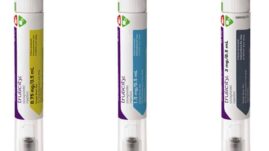Trulicity is a once-weekly injectable medication that helps manage blood glucose (sugar) levels, improve A1c (a measure of glucose control over the previous 2 to 3 months), and even support weight loss.
This article covers everything you need to know about Trulicity dosing.

Key Facts
- Most adults begin with 0.75 milligrams (mg) once weekly, with the possibility of increasing to 1.5 mg after 4 weeks if needed.
- The maximum recommended dose of Trulicity is 4.5 mg once weekly.
- Dose increases should be guided by your doctor, typically after evaluating treatment response and side effects.
- If you miss a dose, take it as soon as possible unless it’s less than 72 hours until your next dose.
Table of Contents
- What dose do you typically start with?
- What is a normal Trulicity dose?
- How and when can you increase your dose?
- What is the correct dose for me?
- What is the correct dose for weight loss?
- What happens if I stop taking Trulicity?
- Are there different Trulicity pens?
- What is the strongest Trulicity?
- What is the maximum weekly dose?
- What do I do if I miss a dose?
What dose do you typically start with?
When starting Trulicity, your doctor will likely begin with a low dose, typically 0.75 mg once weekly, to help your body adjust and minimize side effects. The medicine can be taken with or without food.
Common side effects include nausea, vomiting, diarrhea, fatigue, and suppressed appetite, which can range from mild to severe.
If after 4 weeks you need more blood sugar management and tolerate the medication well, your doctor may increase your dose to 1.5 mg once weekly.
What is a normal Trulicity dose?
There isn’t a “normal” dose, as it varies by the person, but there is a standard “maintenance” dose.
This dose is established after your body has adjusted to the medication, allowing you to gauge its effectiveness for blood sugar management and the severity of any side effects.
Most adults start with 0.75 mg once weekly and, after 4 weeks, increase to a maintenance dose of 1.5 mg. For children ages 10 and up with type 2 diabetes, the starting and maximum maintenance dose is 0.75 mg and 1.5 mg once weekly, respectively.
How and when can you increase your dose?
Dose increases should only be done under your doctor’s guidance. You’ll typically remain on the introductory dose of 0.75 mg for the first 4 weeks to monitor side effects and treatment response.
If additional blood sugar management is needed, your doctor may increase your dose to 1.5 mg.
After another 4 weeks, if further management is required and side effects are minimal, your dose may be increased to 3 mg, and eventually to a maximum of 4.5 mg weekly for adults. The maximum dose for children remains 1.5 mg.
Typical dosing schedule chart
So for adults, a typical Trulicity dosing schedule might look like the following:
| Month | Dosage | Frequency | Notes |
| Month 1 | 0.75 mg | Once weekly for 4 weeks | Starting dose |
| Month 2 | 1.5 mg | Once weekly for 4 weeks | Increase if needed (optional) |
| Month 3 | 3 mg | Once weekly for 4 weeks | Increase if needed (optional) |
| Month 4 and beyond | 4.5 mg | Once weekly | Maximum dose (optional) |
What is the correct dose for me?
Finding the right dose takes time, patience, and possibly some trial and error. It depends on your health history, goals, lifestyle, and how well you tolerate side effects.
Generally, higher doses of GLP-1 agonists like Trulicity can lead to better results, such as lower blood sugar levels, weight loss, and improved A1c, but they also increase the risk of side effects.
Always adjust your dose under your healthcare provider’s guidance.
What is the correct dose for weight loss?
While Trulicity isn’t FDA-approved for weight loss, many users report losing weight while taking it. Since it’s not specifically approved for this purpose, there isn’t an official dose recommended for weight loss.
Trulicity works best for weight management when combined with healthy eating and increased physical activity.
If you’re considering medication for weight loss, consult your doctor about FDA-approved options. Note that you can’t take two GLP-1 agonists simultaneously, like Trulicity and Wegovy or Zepbound.
Other medications, like metformin, can be taken alongside Trulicity to help with weight loss.
Learn more in: Trulicity and Weight Loss: Can Trulicity Help You Lose Weight?
What happens if I stop taking Trulicity?
Never stop taking your diabetes medications without consulting your healthcare provider.
Abruptly stopping Trulicity can lead to adverse effects such as increased hunger, fatigue, weight gain, higher insulin resistance, decreased insulin sensitivity, and elevated blood sugar levels.
If you experience severe side effects, your insurance no longer covers Trulicity, or it no longer fits your lifestyle, speak with your provider about alternative treatments.
Are there different Trulicity pens?
Yes, Trulicity comes in four single-dose pens based on your prescribed dose. For a month’s prescription, you’ll receive four pens, available in the following doses:
- 0.75 mg
- 1.5 mg
- 3 mg
- 4.5 mg
Single-dose pens ensure you can’t accidentally over-inject unless taken more than once a week. However, they also mean there’s no extra medication if a pen is damaged or misplaced.
What is the strongest Trulicity?
All Trulicity pens contain the same active ingredient, dulaglutide, and the larger dosing pens don’t have a stronger formulation — just a higher dose per week.
Increasing your dose means you’re taking more of the medication weekly, not a stronger version.
Always follow your doctor’s prescribed dose and never take more than directed.
What is the maximum weekly dose?
The highest dose of Trulicity you can take each week is 4.5 mg.
You can adjust your dosing day or time as long as it’s been at least 72 hours since your last dose. If it’s been less than 72 hours since your last dose, wait until the following week to pick a new dosing day.
Never take two doses within three days of each other, as this can increase the risk of severe side effects like nausea, vomiting, and dangerously low blood sugar (hypoglycemia).
Symptoms of extremely low blood sugar include dizziness, confusion, rapid heart rate, shallow breathing, shakiness, grogginess, fatigue, and unconsciousness. Seek emergency medical attention if you suspect an overdose.
What do I do if I miss a dose?
Don’t worry — missing one weekly dose won’t immediately raise your blood sugar or cause weight gain.
If you miss a dose and there are at least 3 days until your next scheduled dose, you can take the missed dose without significantly altering your schedule.
If it’s been more than 3 days, skip the missed dose and continue with your next dose as scheduled. Never take two doses within a 72-hour period. To help you remember, set an alarm or reminder on your phone for your weekly dose.
Did you find this article helpful? Click Yes or No below to let us know!





